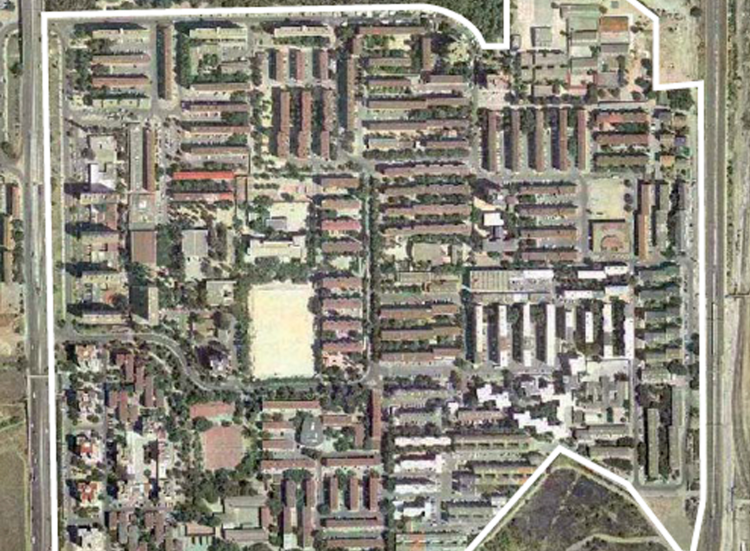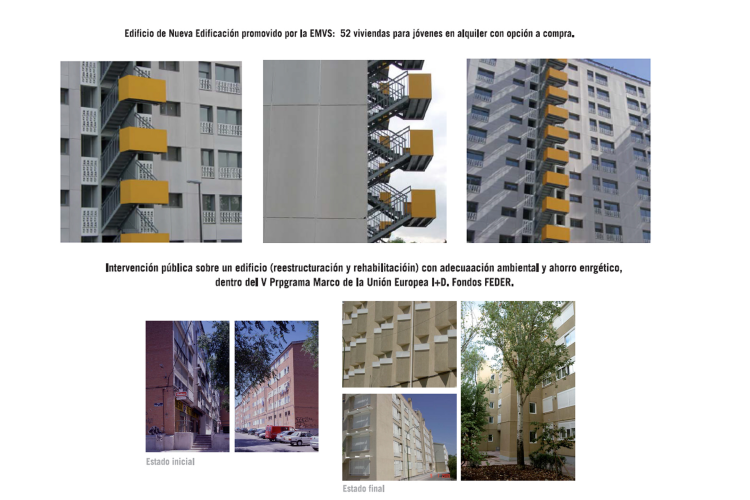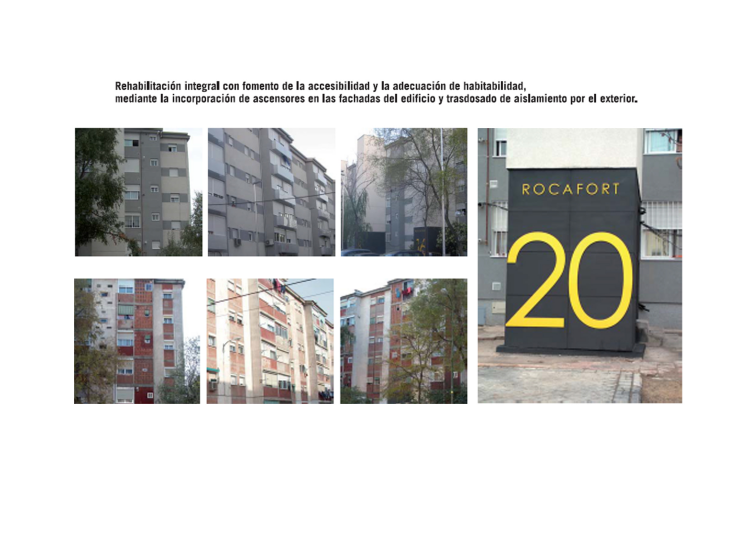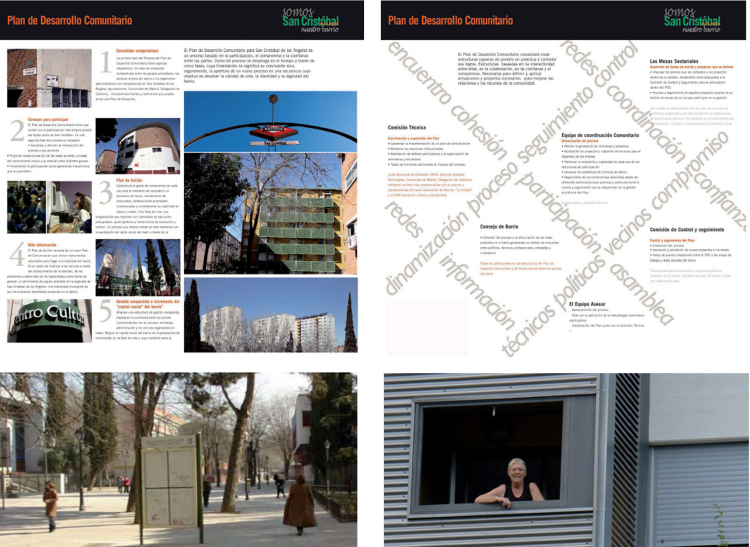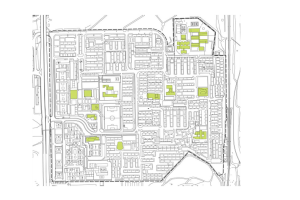1. BACKGROUND: ORIGINS, EVOLUTION AND STATEMENT OF INTEGRATED REHABILITATION AREA SAN CRISTOBAL DE BARRIO OF LOS ANGELES. San Cristobal de los Angeles is one of the five boroughs that make up the Madrid district of Villaverde. Its most important feature has been, for years, physical isolation. The neighborhood is constrained from north to south by the Dehesa Boyal park and military barracks, and from east to west along the railway line Madrid-Andalucía and Andalucía NV road. This isolation positively and negatively affect both the identity and behavior. Demographically, between 1957 and 1967, the neighborhood begins to settle expropriations neighbors from the center of Madrid, employees of companies such as EMT, RENFE, etc. According rectification Registration Office 2007, the district has a population of 16,595 inhabitants, of which 58.84% are nationals and 41.13% are foreign nationals from more than forty countries. Housing is the main problem that pivot neighborhood protests to the different administrations. Between 1969 and 1983 there are many complaints from neighbors regarding structural deficiencies, forcing consolidation undertake works more than 50 buildings and rehabilitation in them, and the rest. The tenure was always deferred property at the time, from the neighbors to be right owners in the 90s. As a result of these protests the Madrid City Council in accordance with the Community of Madrid and the Ministry of Development proposed statement rea Preferential Rehabilitation for the San Cristobal de los Angeles. This proposal was accepted in 1999 and directs the Municipal Housing Company to play the role of Management Body in processing subsidies that are entitled to receive, sunk, owners of homes in the neighborhood. Similarly urbanization and infrastructure renewal of all the neighborhood (street furniture, paving, lighting, power supplies, etc.) are eligible. In 2000 the EMVS opens the Office of Rehabilitation in the neighborhood with the main objective to spread to neighboring benefits that can be achieved in the rehabilitation of buildings, helping to consolidate themselves and improve their homes, providing buildings basic facilities that lack, thus improving not only the habitability, comfort and accessibility, but also the image of the neighborhood and all with a substantial subsidies, which have been increasing over the years. In a first step the work done by the Office of Rehabilitation and ARI is seen with suspicion and distrust by neighbors who do not trust the security they can offer rehabilitation works. However, over the years this view has been minimized and now the rehabilitation of homes and buildings begin to live as a positive opportunity to be seized. 1.1. Investments The scope of intervention of San Cristobal de los Angeles affects 42 acres, 166 buildings with 5,862 apartments. The economic investment amounts to € 64,372,265.40 (64,372,000 hundred and sixty-five euros and forty cents) which was executed an investment in rehabilitation and restructuring of € 38,849,860.88 ( 38.849 million eight hundred sixty euros with eighty-eight cents) which represents 60.35 percent of the total investment. 2. THE ARI DE SAN CRISTOBAL For years is common, and encouraging to note that the word rehabilitation has come and comes with the "integral" adjective, and what at first was an action exclusively rehabilitation of buildings and homes has expanded to interventions public space, energy efficiency, restructuring of buildings, temporary and permanent rehousing of those affected, participatory social intervention through a Community Development Program, etc .. The restructuring, star of interventions in buildings and homes, begins to take its first steps in 2002, when the SLA, as Management Body with the Community of Madrid, agreed to answer buildings with a constructive pathology irreversible and therefore give different response to rehabilitation, through projects accommodate restructuring (demolition and new construction). The Integrated Rehabilitation means facing and responding to all variables (wants and needs) identified through a participatory and multidisciplinary research in the field of action, but a joint and coordinated manner. In this way the same population of the area look like neighbors, residents and citizens also as agents of development, with the support and collaboration of the government and the various professional bodies that are involved in the process of comprehensive rehabilitation ward. One aspect of the context of the overall intervention is sustainable projection of the proceedings, ie, that all efforts to resolve the present needs should be guaranteed to provide for the resolution of future needs. 2.1. The origins of the restructuring process and the first rehousing The building 542 (Godella 13,15,17,19,21) with 54 apartments, in the first half of 2000, was triggered by the first provisional rehousing, shortly after opening the Office of ARI in the neighborhood (January 13, 2000 ). At the same time, the building 810 (Paterna 35,37,39,41,43,45) with 58 homes, which was worse than the previous structural conditions, as well as ratified the first study of Pathology and geotechnics that was developed commissioned by the SLA was in the provisional rehousing and first home purchases were continued. Later he noticed this building to be developed on a project with European funds within the V Framework Programme of the EU: Regen Program Link (R & D on environmental suitability and energy savings in residential buildings). 2.2. The restructuring and social intervention Mentioned the origins of the restructuring process in the neighborhood, I must say, in relation to management, during the years 2003 and 2004 the SLA with the Association of neighborhood residents "Unity", the Regional Federation of neighbors Madrid (FRAVM), Technical and Management Teams consolidate three lines of action: 2.2.1. Final consensus of buildings subject to restructuring (26 blocks and 752 units), March 2005. 2.2.2. Constitution of the Bureau of Rehabilitation Housing San Cristobal de los Angeles, composed of the representatives of the Ministry of Housing, Community of Madrid, EMVS, Villaverde Municipal Board, AA.VV. The Unit, regional federation of associations, Urban Planning and Housing of the City, and Technical and Management Teams. 2.2.3. Analysis of social intervention in the restructuring process. The development of the restructuring of the buildings of the district involves multiple difficulties in its implementation due to existing social, historical and structural factors. San Cristobal has undergone a remarkable demographic aging, due to the limitations of its urban structure and the pathologies of its construction. This aging demographic structure between the native resident population affects the ability to cope rehabilitation processes, especially restructuring, by a group of older people with low incomes. In parallel to this phenomenon occurs, in recent years, the implosion of foreign immigration in the neighborhood, which goes to the periphery where housing prices is lower. Equally they are very low-income sectors and larger households, so this sector of the population, hard, can streamline the process of rehabilitation and, much less, the restructuring. It is important to note, to address any intervention in a neighborhood like San Cristobal de los Angeles, several parameters that will affect the process started from different points of view: to rehabilitation of homes and buildings.: - Pathologies of foundation and structure (Need for rehabilitation or restructuring) - No elevator in 5/6 storey buildings (Lack of accessibility) - Absolute Lack of thermal insulation of buildings. b restructuring process (demolition and new construction).: - There was and confusion and mistrust, appreciation raises serious difficulties in the assimilation of this process by the residents still persists. - Limiting possible for groups of low economic solvency to cope with the costs of restructuring alternatives. - Lack of unanimity required by neighbors by mistrust already mentioned, (increasingly lesser degree). Residents c.: - Increase the degree of residential overcrowding among the foreign immigrant population as a strategy that allows them to bear the costs of mortgage or rent. 2.3.4. Considerations relocation process carried out since the EMVS The lack of rental housing alternatives in the vicinity of the district of San Cristóbal is in anguish and fear that the process produces difficult decision and rehabilitation / restructuring as somewhat insecure lives, sometimes even as a "threat". From the SLA was made available to the process, special regime homes rented or sold to provisional or definitive rehousing in nearby areas (Districts of Usera / Villaverde). When well-defined situations arise: greater with low pensions and / or low-wage immigrants, have had to devise new options that allow unblock the process started. Alternatives such as: - Housing Swaps San Cristobal, in the case of older people, housing special regime, ownership EMVS - Formulas return for rent to own housing in restructured building. From the EMVS entire management involves carrying out the process of relocation of all families affected by the restructuring of its buildings is assumed. 3. THE COMMUNITY DEVELOPMENT PROGRAMME: A TOOL FOR INTEGRAL INTERVENTION AND URBAN REVITALIZATION Community Development is a methodology to implement innovative engagement strategies for achieving the goal of revitalizing and regenerating a community, through integrated approaches that address different aspects: social, economic, educational, architectural, urban and environmental, tending to sustainable development through joint and coordinated involvement of all actors involved in the process: neighbors, professionals and administrations. 3.1. Difficulties Program - Mainstreaming participation of different actors. - Sustainability in the development of the proceedings. - Creating opportunities for reflection, deliberation and consensus decision-making). - Self learning and mutual learning. - To be effective in implementation. 3.3. Organizational Structure - Team Advisor (Carlos III University) - Powerplant (Technical Committee) - Community Coordination Team - Commission of Control and Supervision - Sectoral Tables: · Table rehabilitation · Board of Education · Table of coexistence · Table of economy and local development · Table health · Youth Bureau - Council District (district assembly) The implementation of such a complex initiative and the contradictions and conflicts that appear in its implementation are not easy to solve. However, there is no doubt that these projects are essential in neighborhoods like San Cristobal de los Angeles, linked to the processes of rehabilitation and restructuring, consolidating as the social device Area Rehabilitation needs, enabling a comprehensive and integrated action to ensure the sustainability of the action of revitalization.
Modalidad Integrated operations
Uso
Fecha de inicio de obra 2003-01-01
Fecha del certificado final de obra 2013-12-31
Dirección
Villaverde
Madrid (Spain)
- Carlos Esteban
- Gerardo Ruiz
- Esteban y Ruiz SlL
- Alfonso Azqueta
- Juan M. Medina
- Antonio Rodriguez
- CETSA
- EMVS
- DRACE
- DRACE
- Proyectos y Rehabilitaciones KALAM
- UICESA


